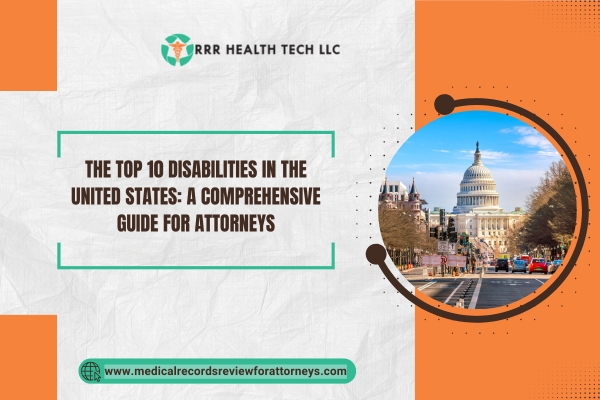
As experts in reviewing medical records for attorneys across America, we know that being abreast of the most recent developments as relates to disabilities is critical. This article outlines the most common disabilities along with their definitions, symptoms, and statistics: The ten most prevalent American disabilities.
What are Disabilities?
Disabilities can be defined as conditions that limit one’s ability to execute daily responsibilities and functions. These may be physical, mental, or emotional in nature, and are often a barrier to achieving an optimal standard of living.
The Top 10 Disabilities in the United States
According to the Centers for Disease Control and Prevention (CDC), the following are the top 10 disabilities in the United States:
- Arthritis: A disabling disease of joints characterized by inflammation that causes stiffness, pain and limited movements.
- Heart Disease: A coronary condition that affects the heart and its circulatory systems and causes increased blood pressure.
- Chronic Obstructive Pulmonary Disease (COPD): A disease of the lungs associated with chronic respiratory issues such as constricted airflow.
- Diabetes: A disorder of the body’s metabolism that leads to excessive blood sugar levels.
- Mental Health Conditions: This includes illnesses like depression, anxiety, and bipolar disorders which directly affect the health of an individual’s mind.
- Stroke: An ailment which remarkably impacts the brains resulting to movement, speech and cognitive problems.
- Chronic Kidney Disease: A disorder of the kidneys that results to the failure of waste disposal and maintenance of fluid balance.
- Alzheimer’s Disease: An impairment of the brain which results to memory loss, cognitive dysfunctions and disruption of normal activities.
- Parkinson’s Disease: A neurological illness that manifests with the symptoms of impaired motor functioning, loss of postural balance, and lack of coordinated movements.
- Spinal Cord Injuries: Injuries that is associated with the vertebral column that leads to loss of motor voluntary activities, sensations, and disturbances in urinary and fecal excretion.
Statistics and Prevalence
According to the CDC, the following statistics highlight the prevalence of disabilities in the United States:
- One out of four adults in the USA has a form of disability.
- In the United States, there are sixty-one million disabled adults.
- The most common ones are arthritis and heart disease as well as COPD.
- Disability is not age specific but there is a higher prevalence in the elderly.
How Medical Records Review Companies Can Help Attorneys
As a medical records review company, we understand the importance of accurate and thorough medical records in disability cases. Our team of experts can help attorneys by:
- Assessing medical documents for important details and contradictions.
- Giving credible evaluation and testimony to aid disability appeal.
- Helping in case planning and development of strategies.
Case Study 1:
Overview of the Case: A woman aged 45 years had a car accident which resulted in her suffering from a spinal cord injury. Due to her condition, she was unable to work and thus sought disability benefits.
Challenges: The federal health care insurer rejected her claim saying she is able to work.
Solutions: Our team assessed her medical documents and provided expert evaluation and testimony to justify her claim. We assisted her lawyer to develop an effective case strategy to win the claim.
Compensation: The woman benefitted with the disability benefit and for her injuries as well.
Case Study 2:
Overview of the Case: A 60-year old man previously employed, now unable to work was diagnosed with Alzheimer’s disease. Therefore, he applied for disability benefits.
Challenges: The health insurance provider dismissed his claim saying he was not considered disabled.
Solutions: Our team of specialists reviewed his medical files and provided analysis and testimony that backed up his disability claim. We coordinated with his attorney to craft an effective case strategy.
Compensation: The man was awarded disability benefits and was paid for his injuries.
Conclusion
As a medical records review company, these examples reaffirm our understanding of how debilitating disabilities impair one’s daily functions. The intricacy and attention-to-detail which involve the analysis of medical records in disability cases, due to our portfolios, is unmatched. We always do our best to provide accurate information and fulfil the expectations of attorneys on these matters. Thus, it is our duty to be knowledgeable regarding the current information that surrounds disabilities so we can offer the best service possible.
